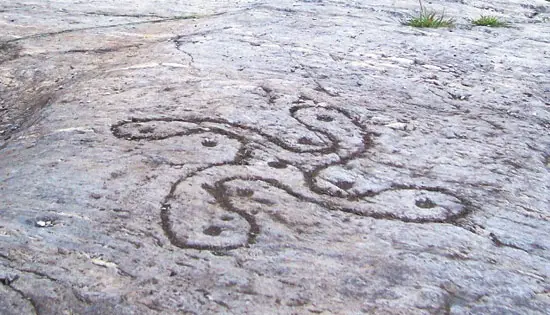The Camunian Rose is a symbol that was found among the Val Camonica rock carvings in Brescia, Italy. There are several theories about its meaning: famed archaeologist Emmanuel Anati posited that it was a religious solar symbol connected to the astral movement. Over time, it developed into a symbol of positive power, with the ability to bring good fortune and long life.
The Camunian Rose is a closed line that wraps gracefully around nine different cup marks. At Val Camonica, 84 “roses” have been found on 27 rocks, all of them complying with three different shape formats:
● Symmetrical
● Asymmetrical
● Swastika
Archaeologist Paola Farina noted that the swastika shape appears to be the oldest and suggested that the Camunian Rose was a local, region-specific variation. Another theory states that the rose is a sort of ancient compass that allowed people to draw perfect circles thousands of years before the wheel was invented.
In Italian, the symbol is called ‘Rosa Camuna’ because all versions bear a strong semblance to flowers. (It is not known what its original name may have been.) An artistic version of the Camunian Rose is now the symbol of the Lombardy Region in Italy.

Symbols Menu:
» Amulet
» Ajna
» Arsenic
» Merkaba
» Hung
» Yin Yang
» bindi
» IK Onkar
» Khanda
» Halo
» jiahu
» Tau
» Uraeus
» Menorah
» Quincunx
» Tilaka
» Taijitu
» Vajra
» Chai
» Chi Rho
» Bagua
» Dragon
» Hunab Ku
» Caduceus
» Infinity
» Ichthus
» Hedjet
» Lauburu
» Om
» Ankh
» Chalice
» Pentacle
» Maat
» Ogham
» Mandala
» Kartika
» Khamsa
» Heart
» Labrys
» Sun Face
» Raven
» Triskele
» Scarab
» Dove
» Hanukia
» Anubis
» Trishula
» Durga
» Mezuzah
» Bay Tree
» Geruda
» Kinnara
» Quito
» Condor
» Blue Jay
» Falcon
» Makara
» Rosary
» Uluru
» Apsaras
» Hanuman
» Serpent
» Minotaur
» Mercury
» Apex
» Vestra
» Yoni
» Astarte
» dakini
» Calabash
» Mandrake
» Rebis
» Typhon
» Vegvísir
